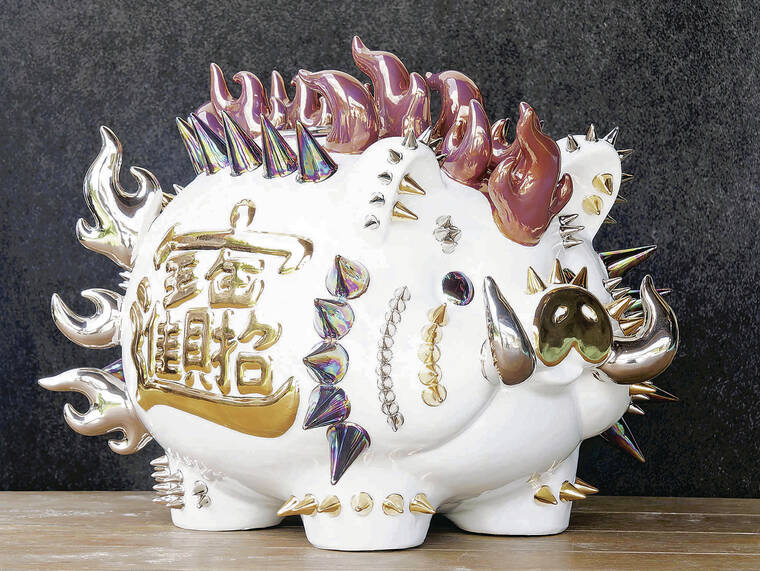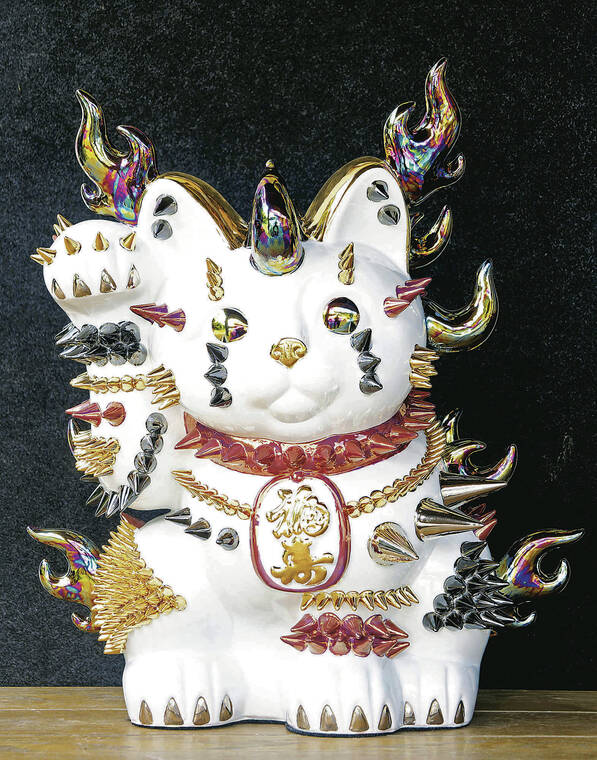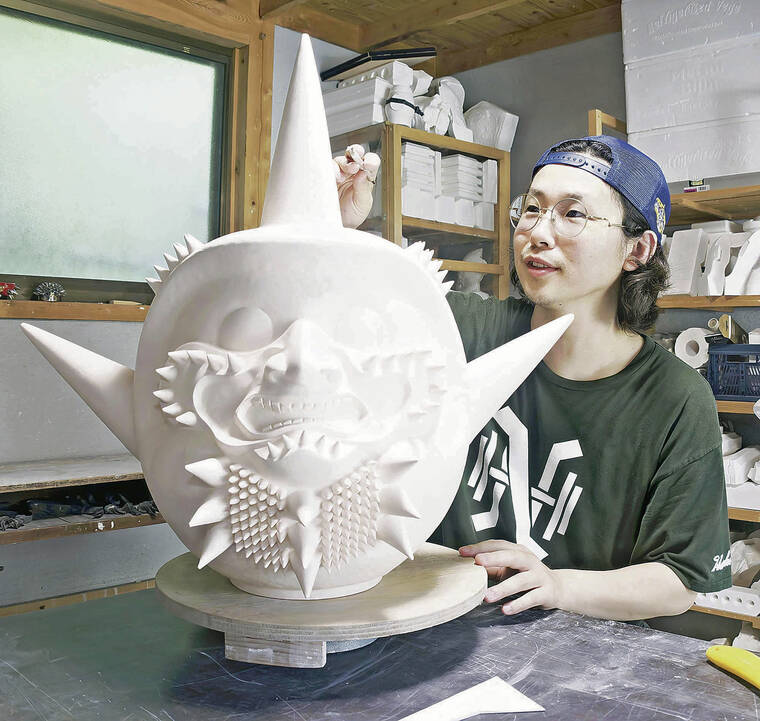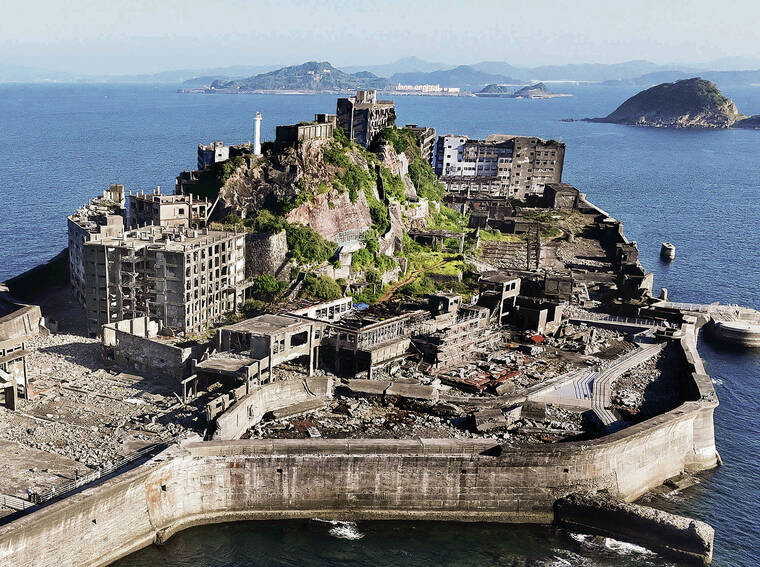Studs add character to ceramic artwork

JAPAN NEWS
Takahiro Koga creates his unique studded ceramic creations at his studio in Nakagawa, Fukuoka prefecture. At top is his work “Pig.”

JAPAN NEWS
Takahiro Koga creates his unique studded ceramic creations at his studio in Nakagawa, Fukuoka prefecture. At top is his work “Neo Manekineko.”

JAPAN NEWS
Takahiro Koga creates his unique studded ceramic creations at his studio in Nakagawa, Fukuoka prefecture.



TOKYO >> Maneki neko, or beckoning cats, come in various colors and poses, but no one had ever heard of a studded maneki neko before.
Ceramist Takahiro Koga, based in Nakagawa, Fukuoka prefecture, is garnering attention at home and abroad with his unique studded ceramic works. Koga, 37, has broken ground in the pottery world with his original style, which gives his pieces an unmistakable presence.
Protruding from his white ceramic maneki neko are cone-shaped gold and silver studs. Similar shapes adorn his sculpture “Neo-Daruma,” whose golden eyes stare out from behind a menbo, or traditional face armor.
At first glance, the works seem to have roots in punk fashion. But it was a white ceramic pot at the Leeum Museum of Art in South Korea that first inspired Koga when he was still a university student. There was power internalized in the piece, and he wanted create pottery with the same impact. He pondered how to express such power, and after some trial and error, he figured out to how to do it: studs.
“They’re an interesting shape, the minimum unit of power,” he said.
Koga also crafts unique cups, called ho yoroi hai, that resemble the menacing face armor worn by Sengoku warlords. He views the unpredictability of today’s world as the era of gekokujo, a term that refers to someone of lower status overthrowing a person of higher status. Through his ho yoroi hai, he expresses a belief that anyone can stand out if they have the will and determination to break new ground.
Don't miss out on what's happening!
Stay in touch with breaking news, as it happens, conveniently in your email inbox. It's FREE!
Koga’s style has been well- received, and he’s produced many works in collaboration with a variety of prominent companies, including Adidas and Tokyo Ghoul, a popular Japanese comic.
The philosophy of Sen no Rikyu, a Japanese tea master who lived from 1522 to 1591, best encapsulates the essence of Koga’s artistic expression. Rikyu intentionally used Japanese- made black tea bowls, at a time when luxurious Chinese vessels were praised, to minimize the presence of the bowl and highlight the tea. Koga was also impressed by the concept of wabi-sabi (an appreciation of spareness and simplicity) and Rikyu’s stance against the prevailing trend.
Koga employs a “neo wabi- sabi” concept to his works to accentuate their presence. The aesthetic, which values imperfection, applies to elaborate and luxurious works as well as simple things, he said.
He creates his ceramic works using traditional techniques that contrast with the opulence of the finished product. The studs, which are made in plaster molds, are glued to the pieces.
Koga was introduced to pottery in 2006 at the Faculty of Culture and Education at Saga University. He started out producing ceramics with white porcelain. After graduation, he continued making art while working at a brewing company in Nagashima, Kagoshima prefecture. At 30, he decided to move to Nakagawa, Fukuoka prefecture.
The turning point in Koga’s career came in 2019 after his Instagram posts of a Tokyo exhibition of his work caught the attention of Adidas. That quickly led to his art being included in a sneaker- themed exhibit. His collaborations have expanded to include famous performers and Italian fashion brands.
Koga’s ceramics were well- received in the U.S. when he showed them in December at the Scope Art Fair in Miami Beach.
“His works evoke a sense of (excitement and) the unusual, reminiscent of what we experience at local festivals. His strong point is his ability to infuse a Japanese context into his creations, even within the U.S.-born modern art world,” said Yuki Tanaka, a Saga University professor who taught Koga.
Koga continues his work with an eye on the future.
“I think antithesis and adversity have created a new culture and tradition,” he said. “I am pursuing pottery on the world stage, with the hope that this will ultimately convey how cool pottery is to younger generations.”




